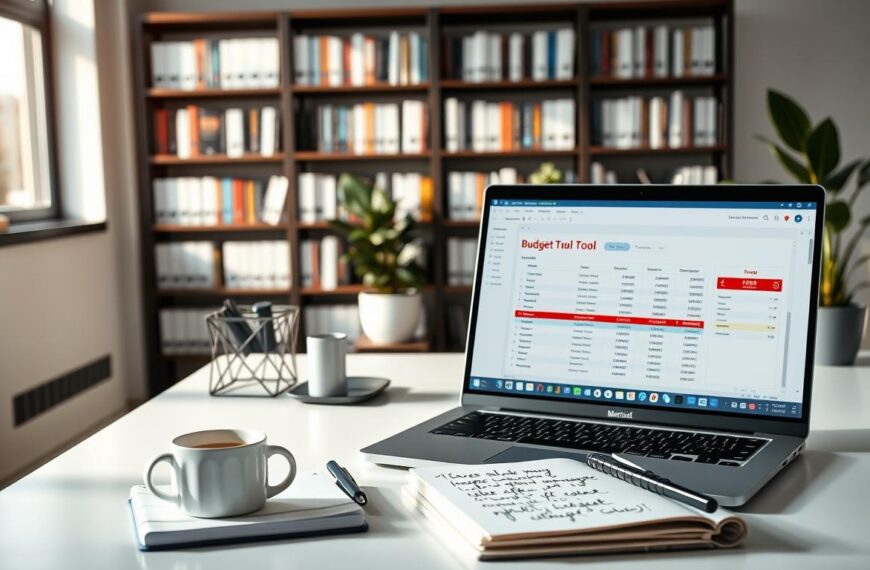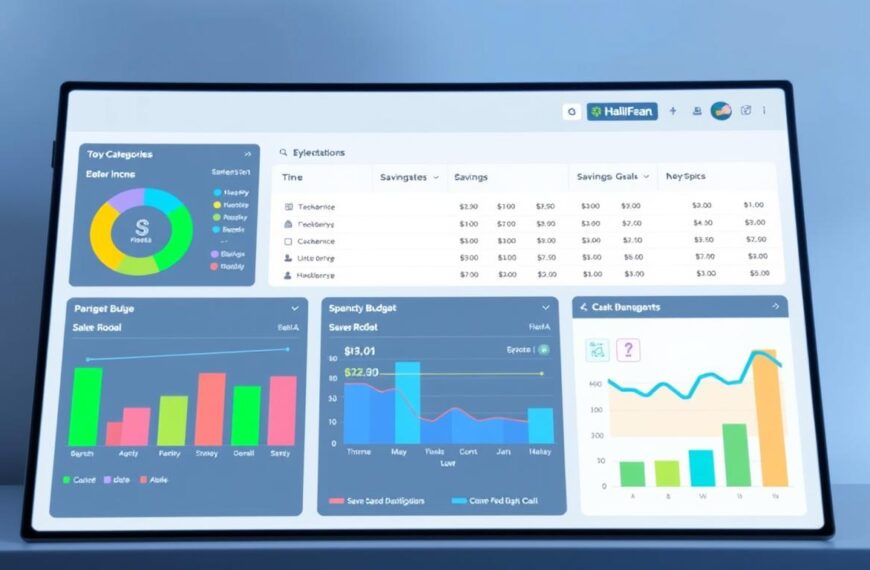Managing your finances effectively is a cornerstone of financial stability, and free budgeting tools can be your most reliable ally. These tools are designed to streamline your financial management, offering a clear and structured approach to tracking your income and expenses. Whether you’re dealing with everyday expenses or unexpected costs like tooth fillings or car repairs, a robust budgeting tool can help you stay on top of your finances1.
A good budgeting tool should cater to a wide range of expenses, including one-off costs and regular bills. It’s essential to have a detailed view of your monthly and quarterly expenses to make informed financial decisions. The free Budget Planner, for instance, assesses your spending against your income, providing a clear picture of where your money is going1.
Using a budgeting tool can help you identify areas where you can cut back and allocate your resources more efficiently. For example, small lifestyle changes, such as cutting out a £2.50 weekday coffee, could lead to an annual savings of over £6001. Moreover, understanding your spending patterns can help you avoid overspending and prevent the risk of entering a debt spiral1.
In this article, we’ll explore various free budgeting tools and demonstrate how they can help you manage your cash flow effectively. Whether you’re looking to save money, reduce debt, or simply gain better control over your finances, these tools offer the accuracy and transparency you need to achieve your financial goals.
Introduction to Budgeting and Financial Efficiency
Managing your finances wisely is key to achieving long-term financial health, especially in today’s challenging economic climate. With rising household costs and unexpected expenses, many individuals and families in the UK are finding it difficult to make ends meet2.
The Current Cost-of-Living Challenge
The cost-of-living crisis has significantly impacted household budgets across the UK. According to recent data, rising bills and living costs have forced many to reevaluate their spending habits3. For instance, a typical household now spends a larger portion of its income on essential expenses such as utilities and groceries.
The Need for Accurate Financial Planning
Accurate financial planning is more crucial than ever. This involves tracking every bill, from utility payments to council tax, to gain a clear picture of your money flow. As highlighted in the MoneySavingExpert guide, understanding where your money goes is the first step towards controlling it effectively2.
A strong financial plan relies on accurate input data, including bank statements, bills, and receipts. This data helps you identify areas where you can cut back and allocate resources more efficiently. For example, small changes like reducing daily expenses can lead to significant savings over time2.
| Category | Impact on Household Budget |
|---|---|
| Utility Bills | Rising energy costs have increased monthly expenses by 15-20% |
| Groceries | Food prices have surged by 10-12%, affecting daily spending |
| Transportation | Fuel and public transport costs have risen by 8-10% |
By understanding the relationship between your income and spending, you can create a more robust financial plan. This not only helps in managing everyday expenses but also prepares you for unexpected costs, ensuring long-term financial stability2.
The Value of Effective Budgeting Tools
Effective budgeting tools are essential for gaining clarity and control over your finances. They provide a structured approach to managing your money, helping you avoid overspending and debt spirals4. By using these tools, you can visualise your spending patterns and set clear financial goals, ensuring that every pound is accounted for.
A well-constructed budgeting plan uncovers hidden savings opportunities. For instance, small adjustments, like cutting out a £2.50 daily coffee, can lead to annual savings of over £6004. These tools also help organise both regular expenses, such as utility bills, and unexpected costs, like car repairs, ensuring you’re always prepared.
Clear financial analysis is key to improved money management. Many tools offer features like fund allocation to different saving pots, enhancing your ability to manage finances effectively5. This technique not only helps in saving but also ensures that you allocate resources efficiently, making your financial plan more robust.
By implementing these strategies, you can achieve long-term financial stability and security. Effective budgeting tools empower you to make informed decisions, ensuring your financial health for years to come.
Comparison of Budgeting Tools Free Options Available
When exploring free options for managing your finances, it’s essential to evaluate the features and benefits each tool offers. With so many choices available, understanding what each tool provides can help you make an informed decision.
Key Features to Look For
- Multiple Account Management: Tools like Emma offer free versions that allow connecting up to 2 bank accounts, while premium versions provide more features6.
- Spending Categories: HyperJar includes a prepaid card and organises spending into clear categories for better tracking.
- Financial Planning: Plum offers a free version with a basic spend tracker and one savings account, with premium options for advanced features7.
- Automatic Tracking: Snoop’s free version includes daily balance updates and automatic spending categorisation, with premium subscriptions offering unlimited custom reports.
Benefits of Using Free Tools
Using a free spreadsheet-based Budget Planner provides a clear view of income and expenses, helping identify areas to cut back. For instance, reducing a £2.50 daily coffee can save over £600 annually6.
Having multiple spending categories allows for precise expense tracking, making it easier to allocate resources efficiently. Choosing the right account setup ensures accurate financial planning and better control over spending.
Each free option has pros and cons. Emma and Plum are great for multiple accounts, while Snoop excels in automatic categorisation. HyperJar’s prepaid card adds an extra layer of spending control. By evaluating these features, you can select the tool that best fits your financial needs.
How a Budget Planner Helps You Manage Spending
A budget planner is an essential tool for anyone looking to take control of their finances. It offers a clear and structured approach to managing your money, helping you keep track of every expense and make informed decisions.
Tracking Expenses Accurately
One of the key benefits of a budget planner is its ability to track every expense accurately. By logging each transaction, you gain a detailed view of your spending patterns. For instance, cutting out a £2.50 weekday coffee can save over £600 annually1. This level of precision helps identify areas where you can cut back, ensuring your money is spent wisely.
Understanding where your money goes is crucial for effective financial management. A budget planner allows you to categorise expenses, making it easier to spot trends and allocate resources efficiently. This clarity is especially important for managing both regular payments and one-off expenses, such as car repairs or unexpected bills.
Setting Realistic Financial Goals
Accurate expense tracking lays the foundation for setting realistic financial goals. Whether you aim to save for a holiday or pay off debt, a budget planner helps you allocate your income effectively. For example, if you want to save £600 for Christmas, you can set aside about £50 each month4.
Using actual figures from your budget planner, you can adjust your spending habits to align with your goals. This might involve reducing non-essential expenses or finding ways to increase your income. By regularly reviewing your budget, you can stay on track and make adjustments as needed.
By integrating expense tracking with goal-setting strategies, you can create a comprehensive financial plan. This approach ensures that every pound is accounted for, helping you achieve long-term financial stability and security.
Customising Your Budget Planner for Personal Needs
Every individual or family has unique financial circumstances, making it essential to tailor your budget planner to meet specific needs. Whether you’re managing household expenses or personal spending, a customised approach ensures accuracy and effectiveness8.
Involve your partner or family members in the process to ensure everyone’s expenses are accounted for. This collaborative effort helps in creating realistic financial goals and avoids overspending. For instance, allocating funds for both essential and discretionary categories like entertainment can prevent budget conflicts1.
| Customisation Tips | Benefits |
|---|---|
| Selecting Relevant Categories | Ensures precise tracking of expenses |
| Setting Personal Financial Goals | Helps in allocating resources effectively |
| Avoiding Expense Duplication | Prevents inaccuracies in financial planning |
By customising your budget planner, you can address specific financial challenges and improve your money management skills. For example, reducing a £2.50 daily coffee habit can lead to annual savings of over £6008.
Visit the UK Government’s Budget Planner for a detailed guide on creating a personalised plan. A well-tailored planner not only enhances financial control but also supports long-term stability8.
Leveraging Technology: Budgeting Apps and Online Systems
Modern technology has revolutionised the way we manage our finances, with budgeting apps and online systems leading the charge. These innovative tools simplify financial management, offering features that enhance savings, track expenses, and provide real-time insights. Popular apps like Monzo, Starling, and Chase offer advanced features such as piggybanking and account segmentation, making it easier to manage your cash flow effectively9.
Automated Savings and Piggybanking
Automated savings are a game-changer for maintaining financial discipline. Apps like Monzo and Starling allow users to set up automated transfers to separate savings pots, ensuring that a portion of your income is saved without any effort9. This method, known as piggybanking, helps users build savings consistently. For instance, setting aside just £10 each week can accumulate to over £500 annually, demonstrating the power of automation in money management10.
Managing Multiple Accounts Easily
Another significant advantage of these apps is the ability to manage multiple bank accounts through a single interface. This feature streamlines financial oversight, allowing users to monitor their cash flow across different accounts seamlessly11. Apps like Chase offer features such as standing orders and automated transfers, which can be set up to allocate funds to savings, bills, or investments efficiently. This centralised management reduces the likelihood of missed payments and helps in maintaining a balanced financial portfolio11.
By leveraging these technological advancements, individuals can gain real-time insights into their financial status, enabling smarter decision-making. For more information on selecting the right budgeting app, visit this guide to explore options tailored to your needs.
Financial Strategies for Debt Reduction and Savings Improvement
Effectively managing debt and savings requires a balanced approach that aligns with your financial goals. By implementing practical strategies, you can reduce debt and improve savings without significant lifestyle changes.
Pain-Free vs Painful Savings Techniques
Pain-free savings methods focus on small, manageable changes. For instance, using a shopping list can help you spend less in supermarkets, as over 60% of people who use one save more12. Automated savings apps can also help you set aside money effortlessly.
Painful savings involve more drastic measures, such as consolidating loans or negotiating lower interest rates on credit cards. While effective, these may require significant adjustments to your spending habits.
For example, cutting back on unnecessary shopping expenses can free up funds for debt repayment. Reducing dining out can redirect £25-£50 monthly towards your debt13.
Visit this guide for more tips on managing credit card and loan repayments effectively.
Harnessing the Piggybanking Technique for Better Money Management
Piggybanking is a simple yet effective method to automate savings and maintain control over spending. By separating funds into distinct accounts or “pots,” individuals can allocate money for specific purposes, ensuring that essential expenses like mortgage repayments are prioritised while still allowing for discretionary spending.
Step-by-Step Guide to Piggybanking
Implementing piggybanking involves a few straightforward steps:
- Open multiple bank accounts or create virtual pots within your existing account.
- Assign each pot a specific purpose, such as bills, savings, or entertainment.
- Set up automatic transfers to each pot based on your budget.
This method ensures that money is allocated thoughtfully, reducing the temptation to overspend and helping build savings over time14.
Maximising Savings with Multi-Pot Systems
Multi-pot systems allow for better organisation of finances. For instance, allocating 50% of income towards needs, 30% for wants, and 20% for savings aligns with the 50/30/20 rule15. This approach not only aids in meeting financial targets but also benefits from interest rates offered by dedicated savings accounts, thereby enhancing overall savings.
For example, setting aside £50 each month for a holiday can accumulate to £600 annually, demonstrating how disciplined money management leads to significant savings14. Additionally, higher interest rates on savings accounts can boost these amounts further.
Visit Which? for more tips on effective money management and savings strategies.
Expert Tips and Real-Life Success Stories
Financial experts and everyday individuals alike have shared valuable insights into effective money management. Their experiences highlight practical strategies and the transformative power of disciplined financial practices.
Advice from Financial Experts
Pamela de la Fuente from NerdWallet emphasizes the importance of understanding your credit information and debt management. She suggests, “Tracking every transaction and categorising expenses is the first step towards financial control.” This approach aligns with the 50/30/20 rule, where 50% of income is allocated to essentials, 30% to discretionary spending, and 20% to savings and debt repayment16.
Experts also recommend automating savings to build a financial safety net. According to MoneySavingExpert, setting up automatic transfers can increase the likelihood of achieving savings goals by up to 50%16. This method ensures consistent savings without requiring constant effort.
| Expert Tips | Benefits |
|---|---|
| Track Every Transaction | Provides clear spending visibility and reduces overspending |
| Automate Savings | Ensures consistent savings and builds a financial cushion |
| Prioritise Needs Over Wants | Helps manage irregular income and avoids debt accumulation |
Real-life success stories further illustrate these strategies. For instance, a UK household reduced their debt by £3,000 in six months by prioritising essential expenses and automating savings. This approach not only improved their financial stability but also reduced stress17.

By following expert advice and learning from real-life examples, readers can adopt sound financial practices. Whether focusing on credit card management or debt reduction, these strategies provide a clear path to long-term financial stability.
Conclusion
In conclusion, effective financial management is a cornerstone of long-term stability, and utilising the right strategies can make all the difference. By implementing techniques such as the 50/30/20 rule, which allocates 50% of income to essentials, 30% to discretionary spending, and 20% to savings and debt repayment18, individuals can achieve a balanced financial plan. Simple adjustments, such as reducing a £2.50 daily coffee habit, can lead to annual savings of over £60019, demonstrating the power of disciplined money management.
Embracing technology, like budgeting apps and automated savings features, can significantly enhance financial control. Tools that offer multi-pot systems and spending categorisation empower users to allocate resources efficiently, ensuring that every pound is accounted for. Regularly revisiting your budget planner and incorporating expert tips can further strengthen financial health, helping to avoid debt spirals and build a robust safety net.
Take immediate action by customising your budgeting approach to suit your needs, whether through spreadsheets or apps. Remember, disciplined budgeting not only leads to significant long-term savings but also paves the way for a debt-free future. Start your journey today and secure your financial tomorrow.
FAQ
Why is tracking expenses essential for financial health?
Tracking expenses helps you understand where your money goes, making it easier to identify areas for cost reduction and improve your financial stability.
How can I set realistic financial goals?
Start by assessing your current income and expenses, then define clear, achievable objectives. Break larger goals into smaller, manageable steps to maintain motivation.
What are the benefits of using budgeting apps?
Budgeting apps offer automated expense tracking, bill reminders, and savings insights, helping you manage your finances more efficiently and stay on top of your spending.
How can I effectively manage multiple bank accounts?
Use a budgeting app to consolidate all accounts in one place. Set up alerts for low balances and schedule regular reviews to ensure everything is in order.
What strategies can help reduce debt?
Consider the snowball method for smaller debts or the avalanche method for higher interest rates. Prioritise needs over wants and allocate a portion of your income towards debt repayment.
How can I customise my budget planner to suit my needs?
Tailor your planner by categorising expenses based on your lifestyle, setting specific financial goals, and regularly reviewing and adjusting your budget as needed.
What should I look for when choosing a budgeting tool?
Opt for tools that offer expense tracking, budgeting features, and financial goal setting. Ensure it aligns with your personal finance needs and is user-friendly.
How can I save money without major lifestyle changes?
Start with small, manageable changes like bringing lunch to work or reducing subscription services. Automate savings to make it a habitual part of your routine.
Why is understanding interest rates important?
Interest rates affect loan repayments and savings growth. Understanding them helps make informed decisions on loans, credit cards, and investment choices.
How often should I review my budget?
Regularly review your budget, ideally monthly, to ensure it reflects your current financial situation and goals. Adjust as necessary to stay on track.
Source Links
- https://www.moneysavingexpert.com/banking/budget-planning/
- https://www.fsb.org.uk/resources-page/budgeting-financial-planning-for-small-businesses.html
- https://corporatefinanceinstitute.com/resources/fpa/budgeting/
- https://capuk.org/money-and-debt-advice/building-a-budget
- https://www.nerdwallet.com/article/finance/best-budget-apps
- https://www.which.co.uk/money/money-saving-tips/budgeting/open-banking-budgeting-and-saving-apps-aLl3e0g9I7Ft
- https://www.cnbc.com/select/best-free-budgeting-tools/
- https://www.iwillteachyoutoberich.com/best-budgeting-spreadsheets-and-tools/
- https://www.equifax.com/personal/education/personal-finance/articles/-/learn/budgeting-apps/
- https://marutitech.com/guide-to-build-a-personal-budgeting-app-like-mint/
- https://fastercapital.com/topics/using-technology-for-budgeting.html
- https://nationaldebtline.org/get-information/guides/making-the-most-of-your-money-guide-ew/
- https://nomoredebts.org/blog/dealing-with-debt/debt-reduction-plan-better-budgeting
- https://themoneycharity.org.uk/media/The-Money-Manual.pdf
- https://www.moneylogue.com/top-25-strategies-for-your-plan-for-saving-money/
- https://www.yourmoneyline.com/blog/beginners-guide-to-budgeting
- https://www.ramseysolutions.com/budgeting/the-truth-about-budgeting?srsltid=AfmBOoqZIRIW7Vdg7Kq29RLXuFG94bjc908DCCxA0JxI7l5H6R-8HkCL
- https://www.smartsheet.com/top-excel-budget-templates?srsltid=AfmBOoqzZ1JHJjYy2HKoqMb-A9NVZMpAs7Qlhv_8jmX1mx1ZO6uZxQ2S
- https://www.nerdwallet.com/article/finance/free-budget-spreadsheets-templates

















